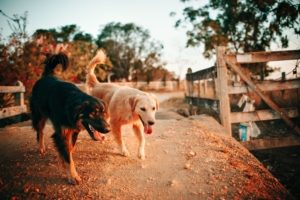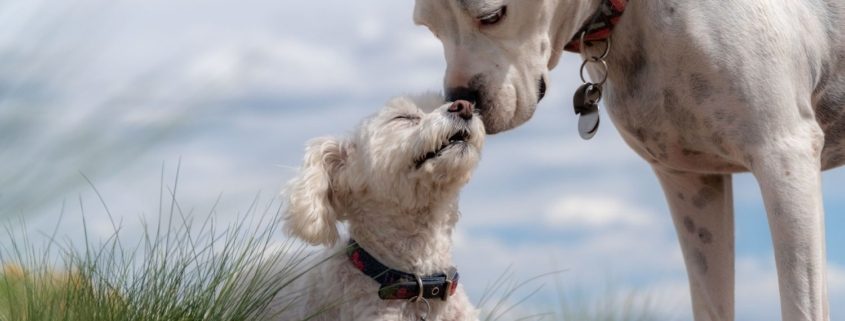Ask Crystal: Growing the Family: Puppy Intro Tips
Welcome to “Ask Crystal,” where you can ask your pet behavior questions! You can submit your question for Crystal at the bottom of the page!
 Dear Crystal,
Dear Crystal,
We have a one-year-old male Bernese Mountain Dog. We are looking to add a second BMD female puppy this spring to our family. What concerns should we have before introducing a younger dog into our home?
Sincerely,
Looking for Love
Dear Looking,
I am so glad that you are thinking about this now before you get the puppy so that you have a plan in place. I am assuming you are asking about the introduction process to the older dog. It seems like a lot of people just assume that a dog will accept a puppy with open arms and that is often not the case. Your dog is young so hopefully he enjoys playing with other dogs. Since you are getting the same breed, I assume they will have similar exercise requirements which can be helpful. It can get really annoying for one dog when they are tired, and the other dog just keeps on going.
First, ask yourself if your dog is ready for another dog in the house. Make sure there aren’t any behavior or training issues that need to be addressed first. Having a puppy is stressful enough without having to deal with existing behavior problems with the adult. There are some behaviors the puppy could start to mirror and then you have two dogs with the same problem. If everything is going well with your dog, then next you will want to consider his personality before selecting your puppy. If he is a very pushy, assertive dog with other dogs, you may want a more submissive personality in the pup. Two assertive dogs can be a bad match at times. If he is fearful or lacks confidence, a more confident puppy may help him gain some confidence. A good breeder will ask you about your home life to help match you with proper puppy. Not all puppies are the same and it isn’t only in how you raise them.
 Second, use neutral ground for intros. When introducing the two dogs for the first time, we have found the best way is to walk on neutral territory. Since you are getting a puppy that isn’t going to have all of its vaccinations completed you won’t be able to go to a park. I suggest walking around your yard instead. You will need a handler for each dog. Each dog should be on a leash. Walk the dogs side by side without being close enough to touch initially. Walk the dogs around and try to get them to calm down before letting them greet. When they do finally greet, we are looking for happy wiggly bodies. If one dog gets very stiff and still, say “let’s go” and get back to walking. Walking is a great way for new dogs to bond. They can be in proximity without touching and both dogs will be distracted by the smells and sights so they can do some mutual sniffing which is relaxing. If you have a fence and the dogs seem relaxed, let them drag leashes but run around a little. Don’t let the play go on for too long as dogs can become overstimulated and things can go south. If the puppy plays inappropriately and the dog growls, that is ok. Just keep an eye on it and separate them if the puppy is being too annoying.
Second, use neutral ground for intros. When introducing the two dogs for the first time, we have found the best way is to walk on neutral territory. Since you are getting a puppy that isn’t going to have all of its vaccinations completed you won’t be able to go to a park. I suggest walking around your yard instead. You will need a handler for each dog. Each dog should be on a leash. Walk the dogs side by side without being close enough to touch initially. Walk the dogs around and try to get them to calm down before letting them greet. When they do finally greet, we are looking for happy wiggly bodies. If one dog gets very stiff and still, say “let’s go” and get back to walking. Walking is a great way for new dogs to bond. They can be in proximity without touching and both dogs will be distracted by the smells and sights so they can do some mutual sniffing which is relaxing. If you have a fence and the dogs seem relaxed, let them drag leashes but run around a little. Don’t let the play go on for too long as dogs can become overstimulated and things can go south. If the puppy plays inappropriately and the dog growls, that is ok. Just keep an eye on it and separate them if the puppy is being too annoying.
Dogs have ritualized ways to engage in play with other dogs. There are set ways to greet, to initiate play and ways to stop play. These rules make play more predictable and therefore more enjoyable. The only rule that puppies have when they play is not to hurt the other puppy. Therefore, puppies have very little social skills and are not aware of the rules of being a dog. Some of these rules include not jumping on the other dog’s head, not stealing their toys, not putting your head in the other dog’s food bowl, not walking on them or sitting on them, and not coming any closer if they don’t want them to. The rules may vary from dog to dog and this list is not all inclusive. Contrary to popular belief a dog does not have to put up with everything a puppy does. In fact, it creates unhealthy expectations and poor social skills for the puppy in the future and it is not fair for the dog. It is very normal for a dog to growl at a puppy when they break these rules. You don’t want to step in as this is how dog’s teach puppies the rules of interacting. This should be limited to growling, snarling and possibly snapping if the puppy does not listen. The dog should not actually make contact with the puppy. You should not punish the dog for appropriate reactions to the puppy’s behavior. However, if the puppy is pestering the dog, he may feel like he needs to take it further so there are some ways to keep the tension down which should prevent aggressive responses. Or if the dog is reacting over the top, you may need to consult a Certified Professional Dog Trainer, you can locate one here.
 Third, always supervise the dog and puppy’s interactions. We need to be around to help guide the puppy who has no social skills and our adults should know that they can count on us to step in if the puppy is being too obnoxious. Puppies can be relentless and even the friendliest adult dog needs a break. Schedule predictable periods of separation of the puppy and dog. We should not force the dog to interact with the puppy constantly. It will be helpful for him to have breaks where he can relax and not have to worry about interacting with the puppy. Baby gates and crates are going to be very useful for periods of separation. Have an escape route for your older dog to retreat to. If your dog likes his crate, you may say, “kennel” and give him a yummy frozen Kong in his crate when you see he is starting to get annoyed. You may find he starts to put himself in there when he gets overwhelmed. Or if he wants to go in another room, close the door and keep the puppy out. Keep the high value treat items for the times when the dogs are separated at this point. Pick them up when they are out together. Dogs may fight over objects when they are feeling stressed out even if they don’t usually guard those items.
Third, always supervise the dog and puppy’s interactions. We need to be around to help guide the puppy who has no social skills and our adults should know that they can count on us to step in if the puppy is being too obnoxious. Puppies can be relentless and even the friendliest adult dog needs a break. Schedule predictable periods of separation of the puppy and dog. We should not force the dog to interact with the puppy constantly. It will be helpful for him to have breaks where he can relax and not have to worry about interacting with the puppy. Baby gates and crates are going to be very useful for periods of separation. Have an escape route for your older dog to retreat to. If your dog likes his crate, you may say, “kennel” and give him a yummy frozen Kong in his crate when you see he is starting to get annoyed. You may find he starts to put himself in there when he gets overwhelmed. Or if he wants to go in another room, close the door and keep the puppy out. Keep the high value treat items for the times when the dogs are separated at this point. Pick them up when they are out together. Dogs may fight over objects when they are feeling stressed out even if they don’t usually guard those items.
Finally, reinforce the behaviors in the dog that you like. If they seem like they are having enough and get up and leave, that is better than staying and fighting. Or if they are calmly laying down around the puppy, that is a great thing to reinforce. It will depend on where you are in the introductions. You will start out reinforcing small things and then increase the difficulty. Remember not to force the dog to stay in the room but encourage when he chooses to.
The more you monitor the dog with the puppy and give breaks, the less often the growling and snapping will occur. Hopefully, around week three the dog will start to feel comfortable enough to start genuine play sessions with the puppy. The best course is to help prevent escalation by careful monitoring so that they can develop a relationship based on trust which will hopefully lead to a long-term friendship. Good luck and have fun with your new puppy!
Until next time,
Crystal
Want more training for your animal? Sign up now for the first session of 2020 Manners 101 classes here!







